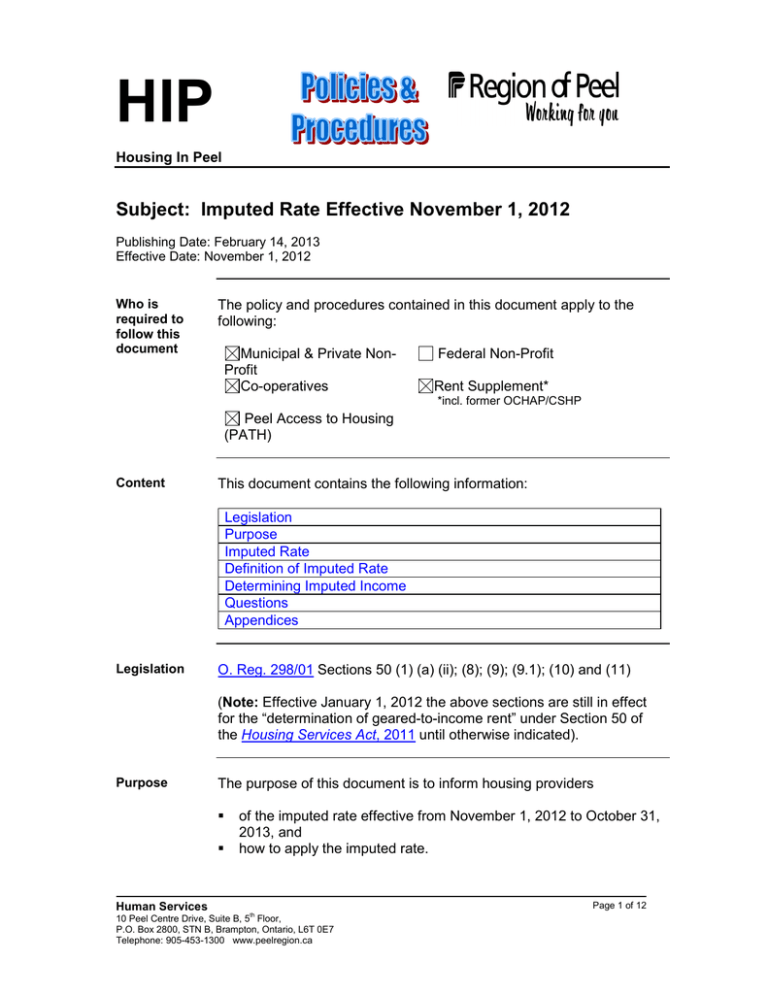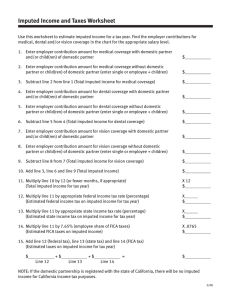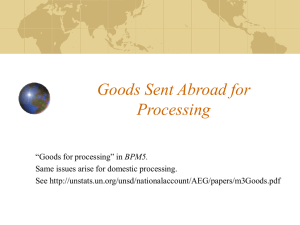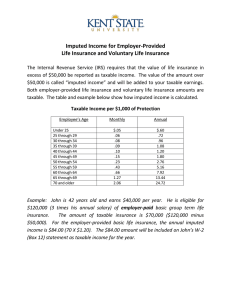Imputed Rate Effective November 1, 2012
advertisement

HIP Housing In Peel Subject: Imputed Rate Effective November 1, 2012 Publishing Date: February 14, 2013 Effective Date: November 1, 2012 Who is required to follow this document The policy and procedures contained in this document apply to the following: Municipal & Private NonProfit Co-operatives Federal Non-Profit Rent Supplement* *incl. former OCHAP/CSHP Peel Access to Housing (PATH) Content This document contains the following information: Legislation Purpose Imputed Rate Definition of Imputed Rate Determining Imputed Income Questions Appendices Legislation O. Reg. 298/01 Sections 50 (1) (a) (ii); (8); (9); (9.1); (10) and (11) (Note: Effective January 1, 2012 the above sections are still in effect for the “determination of geared-to-income rent” under Section 50 of the Housing Services Act, 2011 until otherwise indicated). Purpose The purpose of this document is to inform housing providers of the imputed rate effective from November 1, 2012 to October 31, 2013, and how to apply the imputed rate. Human Services 10 Peel Centre Drive, Suite B, 5th Floor, P.O. Box 2800, STN B, Brampton, Ontario, L6T 0E7 Telephone: 905-453-1300 www.peelregion.ca Page 1 of 12 Imputed Rate The imputed rate effective from November 1, 2012 to October 31, 2013 is 0%. This means that housing providers will not need to apply an imputed income for rent-geared-to-income (RGI) calculations involving non-income producing assets covering the above period of time. Note: Although no income will be calculated on these non-income producing assets, verification documentation should still be requested at the annual income review. Definition of Imputed Rate The imputed rate is the same as the interest rate for the first year of the most recent November issue of Canada Savings Bonds, rounded down to the nearest whole percent. This year, the interest rate for the November 1, 2012 issue is 0.5%. Rounded down to the nearest whole percent it results in 0%. Note: This information is released by the Government of Canada and is available through the Canada Savings Bond website. The imputed rate is used to determine the income on a household’s asset that: is non-income producing does not have an available or identifiable interest rate (i.e. difficult to determine) (use actual when available and identifiable) has been transferred or given away to a person who is not a member of the household or to an organization Reminder: The actual interest rate is to be used when it is available and identifiable. Determining imputed income The following table describes the steps to determine the interest on non-income producing (or transferred) assets. Step 1 Action Verify the current value of the asset/s.* (* Proof of the value of the non-income producing asset should be verified by a written appraisal or statement from the appropriate institution or appraiser). 2 Note: The appendices provide a definition of non-income producing assets as well as information and examples pertaining to specific types of non-income producing assets. Apply the imputed rate to the value/adjusted value of the Human Services 10 Peel Centre Drive, Suite B, 5th Floor, P.O. Box 2800, STN B, Brampton, Ontario, L6T 0E7 Telephone: 905-453-1300 www.peelregion.ca Page 2 of 12 3 4 asset: (value of the asset x imputed rate divided by 100 = annual imputed income). Divide the result by 12 to determine the monthly imputed income. Add the monthly imputed income to the gross monthly household income before determining the RGI rent/occupancy charge. Questions If you have any questions regarding the imputed rate of return, please contact your Region of Peel Housing Programs Administrator. Appendices Appendix I, attached, provides: definition of ‘family unit’ relevant sections in O. Reg. 298/01 pertaining to Imputed Income examples of how to determine imputed income Appendix II, attached, provides definitions and samples of non-income producing assets. Human Services 10 Peel Centre Drive, Suite B, 5th Floor, P.O. Box 2800, STN B, Brampton, Ontario, L6T 0E7 Telephone: 905-453-1300 www.peelregion.ca Page 3 of 12 Appendix I Definition of “Family Unit” “family unit” means, (a) an individual, the individual’s spouse or same-sex partner and all of the children of both or either of them who are living with them, (b) an individual and the individual’s spouse or same-sex partner living with him or her, if neither has any children, (c) an individual and the individual’s children living with him or her, if the individual has no spouse or same-sex partner, or (d) an individual, if the individual has no spouse or same-sex partner and no children; (“cellule familiale”) Imputed Income – Non-Income Producing Assets O.Reg. 298/01, Sec. 50 (8) A non-income-producing Registered Retirement Savings Plan, Registered Education Savings Plan or Registered Disability Savings Plan shall not be included in non-income producing assets for the purpose of subclause (1) (a) (ii). O. Reg. 27/09, s. 2 (5). (9) For the purpose of subclause (1) (a) (ii), the imputed income of a member of a family unit for a month from his or her interest in a non-incomeproducing asset is the amount determined using the formula, in which, "A" is the value of the member's interest in the non-income-producing asset, "B" is one-twelfth of the annual interest rate payable in the first year on the most recent November issue of Canada Savings Bonds, with the annual interest rate rounded down to the nearest whole percentage. O. Reg. 298/01, s. 50 (9); O. Reg. 220/04, s. 10 (3). (9.1) Despite subsection (9), in the case of a family unit with one or more non-interest bearing bank accounts, the imputed income of a member of the family unit for a month from his or her interest in the bank accounts shall be calculated on that part of the average minimum monthly balance that exceeds $1,000. O. Reg. 309/07, s. 20 (6). (10) If a member of a family unit transfers, by sale, lease, gift or in any other manner, his or her interest in an asset to a person who is not a member of the household, less than 36 months before the date the household begins to receive rent-geared-to-income assistance, or any time after the household begins Human Services 10 Peel Centre Drive, Suite B, 5th Floor, P.O. Box 2800, STN B, Brampton, Ontario, L6T 0E7 Telephone: 905-453-1300 www.peelregion.ca Page 4 of 12 to receive rent-geared-to-income assistance, the member shall be deemed, for the purpose of section 8, subclause (1) (a) (ii) and subsection (9), still to have the interest in the asset, unless the service manager is satisfied that the transfer was effected in good faith and, (a) not for the purpose of reducing the member's imputed income so as to reduce the amount of geared-to-income rent payable by the household; or (b) not for the purpose of reducing the amount of the household's assets for the purpose of qualifying for rent geared-to-income assistance, if the service manager has implemented an asset limit under subsection 8 (3). O. Reg. 556/05, s. 12 (3); O. Reg. 309/07, s. 20 (7). (11) If a member of a family unit is deemed under subsection (10) still to have an interest in a transferred asset, the value of the member's interest in the asset on a date that is after the date of the transfer shall be calculated, for the purpose of "A" in the formula in subsection (9), by reducing the value of the member's interest in the asset on the date of the transfer by an amount determined by the service manager on each anniversary of the date of the transfer. O. Reg. 298/01, s. 50 (11); O. Reg. 556/05, s. 12 (4). Examples The following are examples of how to apply an imputed rate in order to determine the interest on a non-income producing asset or on an asset where the actual interest is difficult to determine. Example 1 – Mutual Funds – single ‘family unit’ Mrs. Jones is the only member of the household and she has mutual funds investments worth $30,000. The following table describes the steps to calculate her monthly imputed income. The imputed rate in this example is 1%. Step 1 Action Apply the imputed rate (1%) to the $30,000 to calculate the annual imputed income. ($30,000 x 1 divided by 100 = $300) 2 Divide the $300 by 12 = $25 monthly imputed income 3 Add the $25 to the gross monthly income before determining the monthly RGI rent/occupancy charge. Human Services 10 Peel Centre Drive, Suite B, 5th Floor, P.O. Box 2800, STN B, Brampton, Ontario, L6T 0E7 Telephone: 905-453-1300 www.peelregion.ca Page 5 of 12 Example 2 – Multiple Non-Income Producing Assets – single ‘family unit’ Mr. Smith lives with his spouse and two young children. He and his spouse have nonincome producing assets totaling $8,500, broken down as follows: average minimum monthly balance of $3,500 in a non-interest bearing chequing account, plus $5,000 in stocks. The following table describes the steps to calculate the household’s monthly imputed income. In this example the imputed rate is 3%. Step 1 Action Deduct $1000 from the average minimum monthly balance in the noninterest bearing chequing account. ($3,500 less $1000 = $2,500) 2 Add the $2,500 to the value of the stocks ($2,500 plus $5,000 = $7,500) 3 Apply the imputed rate to the adjusted non-income producing assets $7,500 ($7,500 x 3 divided by 100 = $75 annual imputed income 4 Divide the $75 by 12 to get the monthly imputed income ($75 divided by 12 = $6.25) 5 Add the $6.25 to the gross monthly income before determining the monthly RGI rent/occupancy charge. Example 3 – Multiple ‘Family Units’ Within the Household The household lives in a four bedroom unit and consists of two family units: Mrs. Brown and her 12 year old son (‘family unit’ #1); and Mrs. Brown’s daughter, Helen, and her spouse and baby (‘family unit’ #2). Calculate the gross monthly imputed income for each family unit as follows. In this example the imputed rate is 1%. Family Unit #1 Family unit #1 consists of Mrs. Brown and her son. Mrs. Brown has two non-interest bearing chequing accounts. The minimum monthly balance in these accounts total $3,500 ($2,000; and $1,500). The following table describes the steps to calculate the monthly imputed income for family unit #1. Human Services 10 Peel Centre Drive, Suite B, 5th Floor, P.O. Box 2800, STN B, Brampton, Ontario, L6T 0E7 Telephone: 905-453-1300 www.peelregion.ca Page 6 of 12 Step 1 Action Deduct $1000 from the average minimum monthly balance in Mrs. Brown’s non-interest bearing chequing account. ($3,500 less $1000 = $2,500) 2 Apply the imputed rate to the adjusted non-income producing assets $2,500 ($2,500 x 1 divided by 100 = $25 annual imputed income 3 Divide the $25 by 12 to get the monthly imputed income ($25 divided by 12 = $2.08) 4 Add the $2.08 to the gross monthly income before determining the monthly RGI rent/occupancy charge. Family Unit #2 Family unit #2 consists of Helen and her spouse. They share a non-interest bearing chequing account and keep a minimum monthly balance of $2,500 in the account. The following table describes the steps to calculate the monthly imputed income for family unit #2. Step 1 Action Deduct $1000 from Helen and her spouse’s average minimum monthly balance in their non-interest bearing chequing account ($2,500 less $1000 = $1,500) 2 Apply the imputed rate to the adjusted non-income producing asset ($1,500 x 1 divided by 100 = $15 annual imputed income 3 Divide the $15 by 12 to get the monthly imputed income ($15 divided by 12 = $1.25) 4 Add the $1.25 to the gross monthly income before determining the monthly RGI rent/occupancy charge. Human Services 10 Peel Centre Drive, Suite B, 5th Floor, P.O. Box 2800, STN B, Brampton, Ontario, L6T 0E7 Telephone: 905-453-1300 www.peelregion.ca Page 7 of 12 Appendix II Content Appendix II contains the following information: Definition of Non-Income Producing Assets Financial Holdings Verification of Financial Holdings Real Estate Precious Metals, Gems, Art Transferred Assets Definition of Non-Income Producing Assets Non-income producing assets include all assets, investments or holdings which are intended to increase in value rather than generate regular income. Non-income producing assets include, but are not limited to: 1. Financial holdings (including non-interest bearing accounts) 2. Real Estate 3. Precious metals, gems and art; and 4. Transferred Assets The imputed rate of return is assigned to the value of these assets to determine an imputed income for RGI calculation purposes. For any income producing asset where the annual income is difficult to determine, the imputed rate is applied to the current value of the investment or asset. Note: Interest received from or accrued in a prepaid funeral plan is exempt from income [O. Reg. 298/01 s. 50. (3)19]. Iif the money is withdrawn from the plan and not reinvested in another prepaid funeral it is considered to be an asset. In this case, the actual or imputed income earned on the money should be included in the RGI calculation. 1. Financial Holdings Financial holdings that are considered to be non-income producing assets include: Cash, non-interest bearing chequing accounts or bank accounts where interest is not provided (i.e. non-interest bearing accounts in banks or credit unions). Equity in a business or investment that does not generate an income; Human Services 10 Peel Centre Drive, Suite B, 5th Floor, P.O. Box 2800, STN B, Brampton, Ontario, L6T 0E7 Telephone: 905-453-1300 www.peelregion.ca Page 8 of 12 Taxi cab plates, taxi licenses; Life insurance with a cash surrender value; Non-income producing stocks, mutual funds; Mortgages or loans with an interest rate less than the imputed rate of return. Verification of Financial Holdings The following documents, as appropriate, may be used to verify the current value of non-income producing financial holdings: A copy of an updated bank passbook or financial statement from the financial institution A letter from the financial institution or professional in the field related to the holding A letter from the insurance company that indicates the policy number and the cash surrender value in the case of life insurance with a cash surrender value Verification of the value of the taxi license from the owner of the taxi license such as a receipt for the purchase of the license The schedule of principal and interest pertaining to the loan or mortgage. This should show the current balance of the loan or mortgage as well as the term. Note: Always record the name, address of the financial institution as well as the account number. Types of Financial Holdings The following table describes the types of financial holdings and how to determine the imputed income on the particular type of financial holding. If the financial holding is... Cash, non-interest bearing chequing accounts or bank accounts where interest is not provided Then the imputed income is based on the... annual average minimum monthly balance in the account or a typical recent minimum monthly balance in the account less $1000 from the total sum of all the non-interest bearing accounts for each family unit within the household. (Refer to Example 3 in Appendix I) Equity in a business or investment that does not generate an income Taxi Cab Plate/Taxi confirmed current equity amount in the business Human Services 10 Peel Centre Drive, Suite B, 5th Floor, P.O. Box 2800, STN B, Brampton, Ontario, L6T 0E7 Telephone: 905-453-1300 www.peelregion.ca appropriate portion of the appraised Page 9 of 12 License is used by more than one taxi driver value of the plate Example 1 If a taxi cab plate owner uses the plate for 8 hours and gives/rents it to other drivers, who are not part of the household, for the other 16 hours then 2/3 of the value of the cab plate is considered as a nonincome producing asset Life Insurance with a cash surrender value Non-income producing stocks, mutual funds Mortgage or loans with a loan interest rate less than the current imputed rate Example 2 If a taxi cab plate owner gives/rents the plate to another household member then the greater of the actual rent for the cab plate or the appropriate imputed income is included in the gross income of the cab plate owner. current cash surrender value of the policy plus any accumulated dividends. current value of the stocks or shares. current outstanding principal of the loan or mortgage. Use the imputed rate of return that was in effect the year the mortgage or loan was established. Note: Unlike other non-income producing assets, once the imputed income is determined it will not change until the end of the term of the loan or mortgage. 2. Real Estate The following table describes the treatment of real estate assets for households who receive RGI assistance. If the real estate asset ... is a residential property suitable for year-round accommodation Human Services 10 Peel Centre Drive, Suite B, 5th Floor, P.O. Box 2800, STN B, Brampton, Ontario, L6T 0E7 Telephone: 905-453-1300 www.peelregion.ca Then ... within 180 days (6 months) of beginning to receive RGI or acquiring the property if already in receipt of RGI, each member of the household must: Page 10 of 12 divest himself or herself of any interest in the property; and give written notice to the housing provider of the divestment. The housing provider must inform Peel Access to Housing (PATH) of the sale. non-residential property, which is defined as property that is: (Refer to HIP P&P #7 dated June 21, 2002 for further details on the process for tracking the sale of the property.) treat as a non-income producing asset even if it is rented or producing some income. • not suitable for year round occupancy (non-winterized cottage) • landholding including farm land • real estate producing rental income 3. Precious Metals, Gems, Art Precious metals, gems and art are investments that are intended to increase in value rather than generate income. These do not include personal jewelry, family heirlooms, old family furniture or other personal effects that do not normally increase in value, such as an automobile. The value of the asset can be verified by a written evaluation from a qualified appraiser or through an insurance appraisal. 4. Transferred Assets Timing of Asset Transfer If a member of a household transfers or gives away any assets to a person who is not a member of the household less than 36 months before applying for RGI assistance, or anytime after beginning to receive RGI assistance, the member is considered to still have the asset for rent calculation purposes. If an asset is transferred or given away to a person who is not a member of the household, the value of that asset is treated as nonincome producing. Human Services 10 Peel Centre Drive, Suite B, 5th Floor, P.O. Box 2800, STN B, Brampton, Ontario, L6T 0E7 Telephone: 905-453-1300 www.peelregion.ca Page 11 of 12 Exceptional Circumstances In certain exceptional circumstances assets that have been transferred or given away may not be included in the RGI calculation. For example, if the asset was transferred during the 36 month period prior to applying for subsidized housing and then the applicant experienced an unexpected financial decline or loss, then the transfer of the asset may be forgiven and not included for RGI calculation purposes. Examples of serious financial decline would include: loss of spouse due to death, abandonment or divorce prolonged or permanent loss of employment income (due to illness, injury, plant closing, long-term layoff or other unexpected causes). Annual Write Down of Transferred Assets There is a $2000 annual write down on the value of a transferred asset. The annual write down continues until the full value of the asset is reduced to the final $2000 or less. For example, if the value of the asset is $50,000 at the time of transfer, then Year 1 (year of transfer), the value of the asset is $50,000 Year 2, the value of the asset is reduced by $2000 to $48,000, etc. Verification of Transferred Assets Tenants/members are required to provide verification of the current value of the asset. The following table will describe how transferred assets should be verified. If the transferred asset... has not been sold but there is a major reduction in value is real estate Human Services 10 Peel Centre Drive, Suite B, 5th Floor, P.O. Box 2800, STN B, Brampton, Ontario, L6T 0E7 Telephone: 905-453-1300 www.peelregion.ca Then the tenant/member should... provide documentation to prove the reduced value of the asset provide a certified appraisal as soon as the transfer is complete Page 12 of 12


